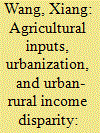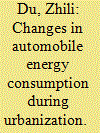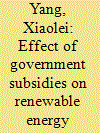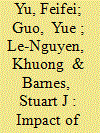|
|
|
Sort Order |
|
|
|
Items / Page
|
|
|
|
|
|
|
| Srl | Item |
| 1 |
ID:
168344


|
|
|
|
|
| Summary/Abstract |
Income inequality is undoubtedly a potential economic and social risk for any country in the world. For China, the improvement in agricultural production capacity and the steady progress of urbanization are fundamental guarantees to mitigate unbalanced urban-rural development and alleviate urban-rural conflict. However, previous studies have paid little attention to the effects of agricultural inputs such as chemical fertilizers on urban-rural income disparity. Based on a data set of 30 provincial-level regions in China over 1997–2015, we use the system generalized method of moments to investigate the impacts of agricultural production inputs and urbanization on urban-rural income disparity. The results show that increasing urbanization has a significant effect on mitigating urban-rural income disparity. The intensity of chemical fertilizer application also has a significant impact on the disparity, but the impact depends on the level of urbanization. For the provinces with relatively low levels of urbanization, an increase in the intensity of chemical fertilizer application can moderate the disparity, while a decline in the intensity of chemical fertilizer application can narrow the disparity in more urbanized provinces. The threshold levels of urbanization present a time-varying characteristic; however, the threshold effects are significant over the entire sample period. Therefore, during the process of further urbanization in China, it is necessary and urgent to appropriately adjust the pattern of chemical fertilizer application and thus reduce the over-dependence on chemical fertilizers in agricultural production.
|
|
|
|
|
|
|
|
|
|
|
|
|
|
|
|
| 2 |
ID:
166965


|
|
|
|
|
| Summary/Abstract |
Automobile sector is one of the important parts of the transportation industry. China's booming auto sector has also brought huge energy consumption, and energy consumption in the automobile sector will continue to increase with the further development of China's economy. Urbanization is a complex process of modernization, and it may be an important reason for the change in automobile energy consumption. According to the current literature, the impact of urbanization may exist as a positive or negative mechanism. Based on the sample of 279 cities in 31 provinces of China from 2003 to 2015, this paper analyzes how urbanization affects automobile energy consumption in the disparity of income, and then it also further explores the heterogeneity of automobile energy consumption in different regions. The conclusion of this paper shows that considering the income disparity, the effect of urbanization on automobile energy consumption increased first and then decreased. The regions with relatively low automobile energy consumption will gradually catch up with the high energy consumption regions, and automobile energy consumption in each region will not converge to its own steady state.
|
|
|
|
|
|
|
|
|
|
|
|
|
|
|
|
| 3 |
ID:
167014


|
|
|
|
|
| Summary/Abstract |
By considering 92 renewable energy listed enterprises in China between 2007 and 2016 as sample, this paper constructs a panel threshold effect model to investigate the threshold effect of government subsidies on renewable energy investment and further explores the effects and differences regarding government subsidy types and enterprise size on the threshold effect. The results show that, first, government subsidies have a positive threshold effect on renewable energy investment of China. When energy consumption intensity and bank credit are greater and the level of economic development is less than the threshold value, the contribution of government subsidies to renewable energy investment is significantly enhanced. Second, monetary subsidies and tax incentive policies can promote renewable energy investment, but the effect of tax incentives is more significant. Third, government subsidies are the main force supporting the development of medium-, small-, and micro-sized renewable energy enterprises. On the basis of these results, the Chinese government should strengthen policy support in those areas with high economic costs of energy transition, encourage the investment in renewable energy in large-sized enterprises, play a policy-guiding role, and focus on strengthening subsidies for medium-, small-, and micro-sized enterprises.
|
|
|
|
|
|
|
|
|
|
|
|
|
|
|
|
| 4 |
ID:
150766


|
|
|
|
|
| Summary/Abstract |
In this research, we aim to understand the influence of government subsidies on enterprises’ research and development (R&D) investment behavior, particularly in China’s renewable energy sector. We are also interested in examining how the attributes of enterprise ownership act as a moderating variable for the relationship between government subsidies and R&D investment behavior. Three classical panel data analysis models including the pooled ordinary least squares (OLS) model, the fixed effect model and the random effect model are employed. We find that government subsidies have a significant crowding out influence on enterprises’ R&D investment behavior and that the influence is further moderated by the attributes of enterprise ownership. Moreover, a panel threshold regression model is used to demonstrate how the influence of government subsidies on enterprises’ R&D investment behavior will change when government subsidies increase. Two thresholds, 0.6% and 10.1%, are identified. We recommend that relevant government departments should motivate enterprise R&D investment behavioral intention by increasing subsidies within a certain range. Different attributes of enterprise ownership should also be considered as part of policy reform and re-structuring relating to government subsidies.
|
|
|
|
|
|
|
|
|
|
|
|
|
|
|
|
| 5 |
ID:
107999


|
|
|
|
|
| Publication |
2011.
|
| Summary/Abstract |
Using official provincial data for gross provincial product, consumer price index and other explanatory variables from 1986 to 2006, the present paper investigates the nonlinear effects of inflation on economic growth in China. The main finding of the study is that the inflation threshold effect is highly significant and robust in China. Above the 2.50 percent threshold, every 1-percentage point increase in the inflation rate impedes economic growth by 0.61 percent; below this threshold, every 1-percentage point increase in the inflation rate stimulates growth by 0.53 percent. This indicates that high inflation harms economic growth, whereas moderate inflation benefits growth. We suggest that China should maintain a moderate inflation rate for long-run growth.
|
|
|
|
|
|
|
|
|
|
|
|
|
|
|
|
| 6 |
ID:
092860


|
|
|
|
|
| Publication |
2009.
|
| Summary/Abstract |
This paper uses a panel threshold regression (PTR) model to investigate the influence that energy prices have on renewable energy development under different economic growth rate regimes. The empirical data are obtained from each of the OECD member-countries over the period from 1997 to 2006. We show that there is one threshold in the regression relationship, which is 4.13% of a one-period lag in the annual gross domestic product (GDP) growth rate. The consumer price index (CPI), in so far as it relates to variations in energy, is significantly positively correlated with the contribution of renewables to energy supply in the regime with higher-economic growth, but there is no relationship in the regime with lower economic growth. Therefore, countries characterized by high-economic growth are able to respond to high energy prices with increases in renewable energy use, while countries characterized by low-economic growth countries tend to be unresponsive to energy price changes when they come to their level of renewable energy.
|
|
|
|
|
|
|
|
|
|
|
|
|
|
|
|
|
|
|
|
|